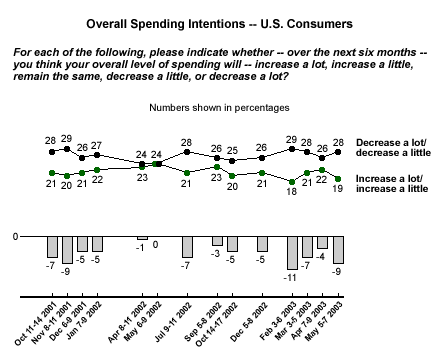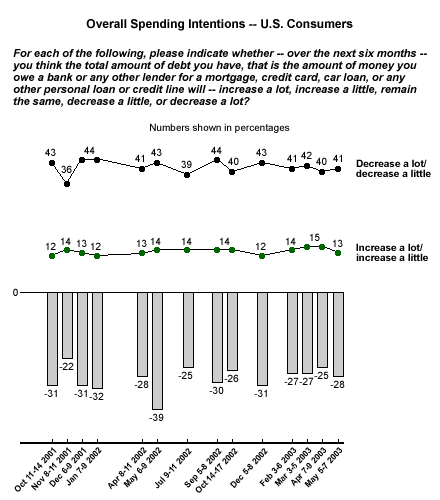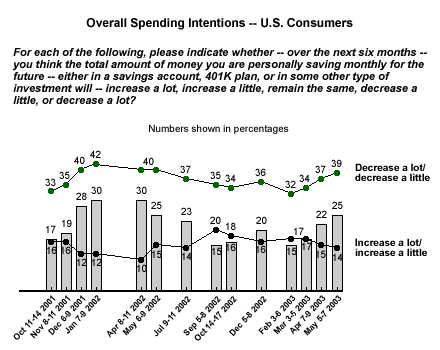Late last week, several retail chain stores reported that they missed their April sales targets. At virtually the same time as these retailers were giving the bad news to Wall Street, American consumers were telling Gallup in a new poll (May 5-7)* that they are planning to spend and borrow less over the next six months than they were in early March, prior to the beginning of the conflict in Iraq. These new economic data reconfirm my view of a month ago: the much-hoped-for post-war economic "rally effect" in consumer confidence and consumer spending was more illusory than real.
Consumers Say the Economy Is Weak
While most on Wall Street and in the business community have the impression that consumer confidence improved during April, few seem to recognize that the immediate boost in confidence following the start of war had already begun to dissipate by mid-April. As a result, they may be surprised that in the latest Gallup Poll, more consumers rated current economic conditions as "poor" (28%) than rated them "good" or "excellent" (22%) -- a differential of negative six percentage points (28% minus 22%). Right now, consumers rate the U.S. economy almost as poorly as they did just before the beginning of the war on March 3-5, when the differential was -10 percentage points. The May ratings also contrast sharply with those of a year ago (May 6-9, 2002), when this differential was +21 -- at that time, 14% of Americans rated economic conditions as poor, while 35% said they were good or excellent.
More Consumers Plan to Spend Less
In May 2003, more consumers say they plan to decrease their level of spending over the next six months (28%) than say they plan to increase it (19%), for a negative differential of nine percentage points. This means consumer spending intentions have returned close to where they were prior to the war in March, when the differential was -7, and in February, when it was -11. This differential shrank during the first half of 2002 and disappeared in May 2002, when 24% of consumers said they planned to spend more and an equal percentage said they planned to spend less. During the second half of last year, this improved consumer-spending outlook dissipated.

Consumers Also Plan to Borrow Less
More consumers also plan to borrow less than plan to borrow more in the months ahead. Forty-one percent of consumers say they plan to borrow less, while only 13% say they plan to borrow more. Once again, this differential of -28 percentage points places consumer borrowing intentions back at their pre-war levels of February and March (-27). The current differential is also just about where it was a year ago, in May 2002 (-29).

Consumers Plan to Save More
Nearly 4 in 10 consumers say they plan to save more over the next six months (39%), while only 14% say they plan to save less. This consumer saving intentions differential (+25) is up from the differentials of February (+15), March (+17), and April (+22). The consumer saving intentions differential is now just where it was a year ago (+25 in May 2002).

Bottom Line
Overall, consumers' spending intentions have not improved since before the war. The surge in consumer confidence that did occur during the war has turned out to be very short-lived. The unemployment situation continues to scare consumers, as reflected by the way precautionary saving continues to increase.
About the only positive as far as consumer attitudes are concerned is that 42% of consumers say economic conditions are "getting better" in May, up from 36% who felt this way in April and 23% in March. Still, even as more consumers say things are "getting better," 51% of the public still thinks economic conditions are "getting worse."
In sum, the positive stimulus to the U.S. economy resulting from the war was minimal to non-existent. Businesses do not seem to be increasing their spending, nor do they appear to be hiring new employees. And those who are counting on increased consumer spending to lead the recovery may as well look elsewhere, it's simply not a good bet.
*Results are based on telephone interviews with 1,005 national adults, aged 18 and older, conducted May 5-7, 2003. For results based on the total sample of national adults, one can say with 95% confidence that the maximum margin of sampling error is ±3%.
